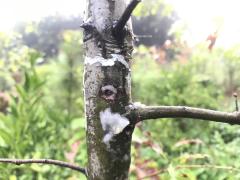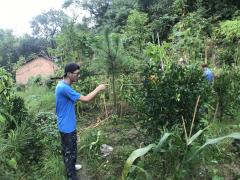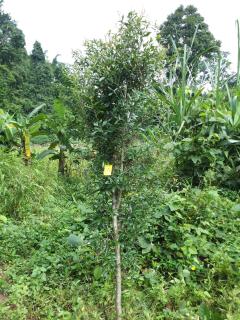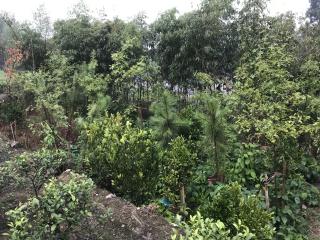# Trees growing far from home are forests’ first line of defense
Korey Morgan
October 11, 2022
Trees Growing Far from Home are Forests’ First Line of Defense
Imagine a young red oak growing in an open meadow, its limbs reaching towards the bright October sky. As fall sets in, its broad leaves are turning a scarlet hue. But this iconic tree is not growing in a New Jersey park or deep in a hardwood forest in Vermont, rather it stands conspicuously in a lush garden just outside of Nanjing, China.
A growing network of gardens in East Asia, Europe, and the U.S. cultivate tree species native to other parts of the world. These so-called “sentinel gardens” are more than collections of exotic plants. They stand as the first line of defense for forests and may just uncover the next dangerous invasive pest or pathogen—but just hasn’t arrived yet.

Wood boring insect lay eggs in trees. As larvae develop, they feed on the tree, weakening and sometimes killing the host. Native trees have developed natural resistance to native insects. (University of Florida photo by Jiri Hulcr)
“These trees are like a canary in a coal mine,” said Isabel Munck, plant pathologist with the Forest Service’s Eastern Region State and Private Forestry field office. “They are out ahead of the threat and are providing us with important information about potential invasive species.”
Invasive species of insects and fungi know no boundaries or borders. They devastate individual trees and large swaths of forests. The Forest Service is partnering with research institutions in the U.S. and abroad to support and grow sentinel gardens as one way to respond to this threat.
“Europeans have been using this approach to identify potential invasive species for some time,” said Beth Lebow, invasive species program coordinator for the Forest Service’s International Programs. “When we looked around and saw that this wasn’t widely used in the U.S., we began reaching out to and engaging interested partners.”
The Forest Service now funds and supports nine gardens on three continents: Asia, Europe and North America.
Back in China, a team of researchers from Nanjing Forestry University monitor species of trees that were handpicked by partners in the U.S. and Europe for their economic, ecological, and cultural value. North American species include well-known trees like paper birch, eastern white pine, yellow poplar, Shumard oak, northern red oak, and red maple, all found in the eastern U.S. and along the same latitude as their native range.

Researchers examine trees to see which pests attack, the severity of the outbreaks, and the tree’s natural defenses to fight them off. Researchers in China then share their findings with their counterparts in the U.S. and Europe. (University of Florida photo by Jiri Hulcr)
“It was difficult to come to a decision on which species to observe,” said Enrico Bonello, plant pathologist with the Ohio State University. “We decided very early on that it would be too dangerous to move plant materials from one continent to another, so we had to find trees that met our criteria and are also commercially available in the country.”
Scientists are interested in learning how local fungi and insects interact with these tree species, and whether they can be a threat. They collect data on which organisms attack, the severity of outbreaks, and the effectiveness of the tree’s natural defenses to fight them off. Their findings are shared with their colleagues in the U.S. and Europe.
Meanwhile, more than 7,000 miles from Nanjing, more than 500 trees representing six Asian and six European species grow in sentinel gardens in New Hampshire, Ohio, and Florida. Like the team in China, scientists from the Ohio State University, the University of Florida, the Forest Service, with the help of other partners, monitor how pests and pathogens native to U.S. are affecting Asian and European trees’ health.
“This is truly a collaborative program that depends on partnerships with our colleagues abroad. Our partners relay information about the trees we care about, and we in turn relay data back to them,” said Munck.
This close collaboration is paying off. Researchers are making breakthroughs in understanding threats that were previously unknown to scientists.
“Sentinel gardens are teaching us a lot. There is one variety of Asian long horned beetle, for instance, that is normally found in citrus trees. It kept showing up on American oaks, which is something we did not expect” said Jiri Hulcr, entomologist at the University of Florida. “As the females laid eggs in the tree and the larvae were developing, they were causing these oak trees to die. That’s pretty scary, and very important for us to understand.”

The icon of Southeastern American landscape, the live oak (Quercus virginiana) grows in a partner’s sentinel garden in Yunnan province. (University of Florida photo by Yiyi Dong)
Internationally, the Forest Service has helped to establish sentinel gardens in Italy, Sweden, and China. There are plans for a garden in South Korea by 2024.
“Many people in the U.S. may see invasive species as a uniquely North American problem, but that simply isn’t the case” said Munck. “Invasive species native to North America have already caused a lot of trouble on other continents.”
The turpentine beetle is one example of an insect native to North America that has wreaked havoc on trees in other continents.
“In the U.S. it is not a tree-killing beetle, but in Asia where it has been introduced, it has caused a lot of mortality.” said Bonello.
Through observation and discovery, scientists are building knowledge about potential invasive species. Perhaps even more important than a growing library of knowledge, though, are the relationships researchers are developing with their counterparts overseas.
“We are establishing partnerships, developing working relationships, and sharing information,” said Hulcr. “We are learning how to work together to establish these gardens and sharing expertise. This seemingly simple act of exchanging information is hugely beneficial.”
These relationships may just prove key in the future. Some invasive species are already household names: the spotted lantern fly, the spongy moth, and the emerald ash borer all affect forests in North America. They will certainly not be the last.
For more information on how the Forest Service is working to stem outbreaks of invasive species, visit the Forest Service website.
To learn how the agency is working with international partners to predict and stop the spread of invasive species, visit the Forest Service international programs webpage.

Trees native to other parts of the world grow in sentinel gardens among local plants. (University of Florida photo by Jiri Hulcr)